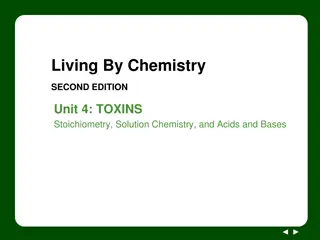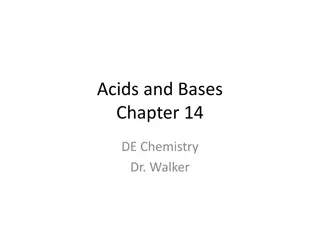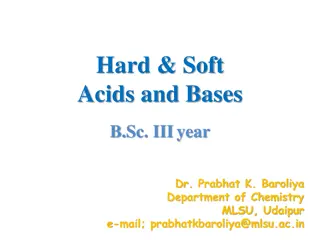Theories of Electrolytic Dissociation and Ionization in Physical Chemistry
The theories of electrolytic dissociation by Adil Hamid and Arrhenius explain how electrolytes dissociate into ions in solution, leading to electrical conductivity. This process involves the migration of cations and anions towards opposite electrodes, affecting the conductivity of the electrolyte. T
1 views • 51 slides
Understanding Acids and Bases: Definitions and Behavior
Explore the definitions of acids and bases according to Arrhenius and Brønsted-Lowry theories, their behavior at a particulate level, and the differences between strong and weak acids and bases. Learn how to define, identify, and understand the properties of acids and bases through practical exampl
0 views • 12 slides
Introduction to Analytical Chemistry and pH Detection
Analytical chemistry involves the study of detecting acids and bases in solutions, with methods such as litmus testing and the Arrhenius definition. The concept of conjugate acids and bases, acid dissociation, and buffer solutions are also key components in understanding chemical properties and reac
1 views • 36 slides
Understanding Acids and Bases: A Comprehensive Overview
Learn about the fundamental concepts of acids and bases, their classifications, and key theories by Arrhenius and Brønsted-Lowry. Explore the importance of pH balance in living organisms and how different substances exhibit acidic or basic properties through informative visuals.
0 views • 34 slides
Understanding Analytical Chemistry Concepts and Applications
In the realm of analytical chemistry, various methods are employed to detect acids and bases in solutions. Litmus, a natural dye, is commonly utilized for this purpose, turning red in acidic conditions and blue in basic conditions. The slides presented touch upon key concepts such as the Arrhenius d
0 views • 47 slides
Understanding Acids and Bases: The Fundamentals Explored
Explore the foundational concepts of acids and bases, from Arrhenius to Lewis definitions. Delve into how these theories explain chemical reactions and properties, highlighting the significance of proton transfer and electron interactions in determining acid-base behavior.
0 views • 29 slides
Understanding Acid-Base Chemistry Theories and Buffers
Explore the concepts of acids, bases, and buffers through various theories such as Arrhenius, Lowery-Bronsted, and Lewis. Learn about the limitations of the Arrhenius theory and delve into different types of buffer solutions that help resist pH changes. Gain insights into the definitions, examples,
4 views • 36 slides
Understanding Acids and Bases in Chemistry: Key Concepts and Terminology
This chapter delves into the fundamental concepts of acids and bases in chemistry, covering Arrhenius, Bronsted-Lowry, and Lewis definitions. It discusses conjugate acids and bases, acid dissociation, dissociation of strong and weak acids, and the differences between strong and weak acids/bases. The
0 views • 41 slides
Understanding Hard & Soft Acids and Bases in Chemistry
Explore the concepts of hard and soft acids and bases in chemistry, including the Arrhenius, Brønsted-Lowry, Lewis, and Solvent System models. Learn about the HSAB principle introduced by R.G. Pearson, discussing polarizing power and polarizability of acids and bases. Understand how these principle
0 views • 15 slides








